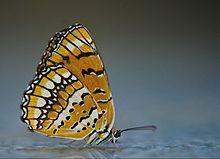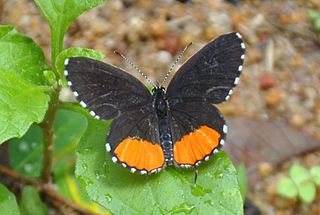
Talicada nyseus, the red Pierrot, is a small but striking butterfly found in the Indian subcontinent and South-East Asia belonging to the lycaenids, or blues family. The red Pierrots, often found perching on its larva host plant, Kalanchoe, are usually noticed due to their striking patterns and colors.
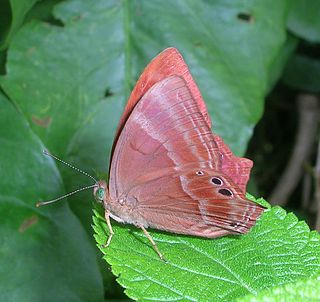
Abisara echerius, the plum Judy, is a small but striking butterfly found in Asia belonging to the Punches and Judies family (Riodinidae). It is difficult to distinguish it from Abisara bifasciata.

Graphium antiphates, the five-bar swordtail, is a species of papilionid butterfly found in south and southeast Asia. The species was first described by Pieter Cramer in 1775.

Parnassius hardwickii, the common blue Apollo, is a high-altitude butterfly which is found in South Asia. It is a member of the snow Apollo genus (Parnassius) of the swallowtail family (Papilionidae). This butterfly is found from the Chitral District to Sikkim and is found from 6,000 to 17,000 feet, making it one of the most commonly encountered species of Apollo in the Indian subcontinent.

Luthrodes pandava, the plains Cupid or cycad blue, is a species of lycaenid butterfly found in India, Sri Lanka, Myanmar, United Arab Emirates, Indochina, Peninsular Malaysia, Singapore, Taiwan, Java, Sumatra and the Philippines. They are among the few butterflies that breed on plants of the cycad class.

Athyma selenophora, the staff sergeant, is a species of nymphalid butterfly found in tropical and subtropical Asia.
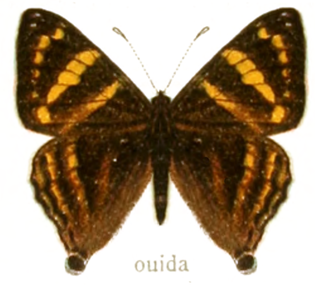
Dodona ouida, the mixed Punch, is a small but striking butterfly found in the Indomalayan realm in West China, Himalayas, Northeast India (hills) and Burma that belongs to the Punches and Judies, that is, the family Riodinidae.

Colotis fausta, the large salmon Arab, is a small butterfly of the family Pieridae, that is, the yellows and whites, which is found in Israel, Syria, Turkey, Iran, Afghanistan, Turkmenistan, India, Arabia, Chad, Somalia and United Arab Emirates.

Charaxes marmax, the yellow rajah, is a butterfly found in India that belongs to the rajahs and nawabs group, that is, the Charaxinae group of the brush-footed butterflies family.
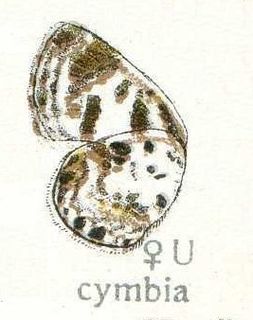
Niphanda cymbia, the pointed Pierrot, is a small butterfly found in northern India, Burma and northern Borneo that belongs to the lycaenids or blues family.

Hypolimnas misippus, the Danaid eggfly, mimic, or diadem, is a widespread species of nymphalid butterfly. It is well known for polymorphism and mimicry. Males are blackish with distinctive white spots that are fringed in blue. Females are in multiple forms that include male-like forms while others closely resemble the toxic butterflies Danaus chrysippus and Danaus plexippus.

Neptis columella, the short banded sailer, is a species of nymphalid butterfly found in South and Southeast Asia.

Kaniska canace, the blue admiral, is a nymphalid butterfly, the only species of the genus Kaniska. It is found in south and southeast Asia.

Athyma nefte, the colour sergeant, is a species of brush-footed butterfly found in tropical South and Southeast Asia.

Cethosia nietneri, the Tamil lacewing, is a species of nymphalid butterfly found in Sri Lanka and south India. The species name is after John Nietner who obtained specimens of the butterfly from Ceylon from which it was described.

Lethe drypetis, the Tamil treebrown, is a species of Satyrinae butterfly found in south India and Sri Lanka.

Vindula erota, the common cruiser, is a species of nymphalid butterfly found in forested areas of tropical South Asia and Southeast Asia.

The Indian fritillary is a species of butterfly of the nymphalid or brush-footed family. It is usually found from south and southeast Asia to Australia.

Pantoporia hordonia, the common lascar, is a species of nymphalid butterfly found in Cambodia, tropical and subtropical Asia.

Stichophthalma sparta, the Manipur jungle queen, is a butterfly found in South Asia that belongs to the Morphinae subfamily of the brush-footed butterflies family.

